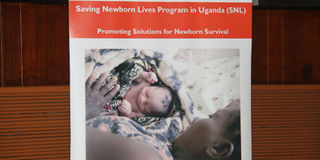Infant death can be reduced with better care and hygiene

Nearly 25 per cent of infant deaths can be prevented by ensuring good hygiene and thermal protection. Photo by Abubaker Lubowa.
Uganda has made a progress on the journey towards achieving the Millennium Development Goals (MDGs) 4 and 5.
However, Uganda loses more than 5000 mothers, 30,000 newborns and 35,000 stillbirths yet there are technologies and policy guidelines that can ensure safety for a mother and her newborn baby.
With an action plan for maternal and newborn health, Uganda intends to end preventable maternal deaths with a target to save three million lives of newborns, women and reduce number of still births each year.
According to Dr Charles Kiggundu the chairperson Association of
Gynaecologists and Obstetricians in Uganda, there has been slow action on the death of women.
“16-18 women die daily accounting for 6000 maternal deaths annually in Uganda due to preventable causes,” says Dr Kiggundu.
According to Prof Joy Lawn, a global and newborn health icon and director of Centre for Maternal, Adolescent, Reproductive and Child Health, safe delivery in Africa depends on how wealthy parents are.
“There are 36 million live births in Africa per year; however 36 per cent of deliveries are by the women themselves at home, 12 per cent at home with a traditional birth attendant, two per cent at home with a midwife while 50 per cent deliver at a health facility,” she reveals.
Why prioritise maternal & newborn health?
30-40 per cent of infant deaths in Uganda occur due to poor care during pregnancy and delivery. Maternal health issues account for 18 per cent of the disease burden in Uganda according to Prof Fred Ssengooba
Prof Barbara Burroughs the country coordinator Save the Children Uganda says, “It will take 110 years for a child born in Africa to have the same survival rate as a child born in Europe.”
She however adds, “Nearly 25 per cent of the infant deaths can be reduced by ensuring good hygiene by mothers such as washing hands, good cord care, breastfeeding and thermal protection.”
Status of MDG implementation
“Millennium Development goals (MDGs) end October this year.
Some countries have met the goals up to the 4th but a lot more has to be done as many things have not been achieved,” says Prof Lawn.
Uganda is failing to implement low cost interventions because the country is poor at following its own policies, according to Dr Romano Byaruhanga.
Maternal mortality ratio had been targeted to be less than 150 deaths per 100,000 live births by October 2015 but it is still as high as 480 deaths per 100,000 live births.
Why progress is still slow
For all the investments the government has made into the health sector, Dr Ismail Ndifuna a senior programme specialist in Sexual and Reproductive Health Rights at UNFPA says there should have been a demographic dividend because the population is dynamic so returns are expected in respect to human rights.
This has however not been achieved because many people especially women do not know their sexual and reproductive health rights.




